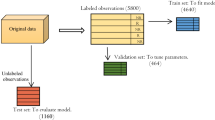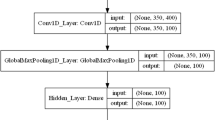Abstract
The far and wide distribution of innumerable rumors and fake news have been a serious threat to the truthfulness of microblogs. The earlier works have frequently aimed at remembering the earlier state with n consideration to the next context information. Also, a majority of the works before have made use of conventional feature representation approaches preceding a classifier. In this research, we evaluate the rumor detection problem by examining multiple Deep Learning approaches, with a focus on forward and backward direction analysis. The proposed technique incorporates Optimal Bidirectional Long Short-Term Memory and Convolutional Neural Network in order to correctly classify tweets as rumor or non-rumor. Then the Biogeography-based optimization (BBO) provides recommendations for fine-tuning the Bi-LSTM-CNN model's hyperparameters. According to the results of the experiments, the suggested technique is more precise than conventional methods, with an accuracy of 86.12%. The statistical analysis further demonstrates that the suggested model is much more successful than the appropriate alternatives.









Similar content being viewed by others
Data availability
Not Applicable.
References
Bali A, Desai P (2019) Fake news and social media: Indian perspective. Media Watch 10(3):737–750
Yang F, Liu Y, Yu X, Yang M (2012) Automatic detection of rumor on sina weibo. In Proceedings of the ACM SIGKDD workshop on mining data semantics, p 1–7 https://www.semanticscholar.org/paper/Automatic-detection-of-rumor-on-Sina-Weibo-Yang-Liu/96b17f09f3afcc9238c1789208eeb016bc2a84d8
Vosoughi S, Mohsenvand MN, Roy D (2017) Rumor gauge: Predicting the veracity of rumors on Twitter. ACM transactions on knowledge discovery from data (TKDD) 11(4):1–36
Sun S, Liu H, He J, Du X (2013) Detecting event rumors on sina weibo automatically. In: Asia-Pacific web conference. Springer, Berlin, Heidelberg, pp 120–131 https://springer.longhoe.net/chapter/10.1007/978-3-642-37401-2_14
Meel P, Vishwakarma DK (2020) Fake news, rumor, information pollution in social media and web: A contemporary survey of state-of-the-arts, challenges and opportunities. Expert Syst Appl 153:112986
Ahsan M, Kumari M, Sharma TP (2019) Rumors detection, verification and controlling mechanisms in online social networks: A survey. Online Social Networks and Media 14:100050
Tan L, Wang G, Jia F, Lian X (2022) Research status of deep learning methods for rumor detection. Multimed Tools Appl 82(2):2941–2982
Islam MR, Liu S, Wang X, Xu G (2020) Deep learning for misinformation detection on online social networks: a survey and new perspectives. Soc Netw Anal Min 10(1):1–20
Wang B, Chen G, Fu L, Song L, Wang X (2017) Drimux: Dynamic rumor influence minimization with user experience in social networks. IEEE Trans Knowl Data Eng 29(10):2168–2181
Wu Q, Zhao X, Zhou L, Wang Y, Yang Y (2019) Minimizing the influence of dynamic rumors based on community structure. Int J Crowd Sci 3(3):303–314
Hosni AIE, Li K, Ahmad S (2019) DARIM: Dynamic approach for rumor influence minimization in online social networks. In: International conference on neural information processing. Springer, Cham, pp 619–630. https://www.researchgate.net/publication/335910204_DARIM_Dynamic_Approach_for_Rumor_Influence_Minimization_in_Online_Social_Networks
Hosni AIE, Hafiani KA, Chenoui A, Beghdad Bey K (2022) Hybrid approach for rumor influence minimization in dynamic multilayer online social networks. In: International conference on computing systems and applications. Springer, Cham, pp 275–285. https://springer.longhoe.net/chapter/10.1007/978-3-031-12097-8_24
Ni P, Zhu J, Wang G (2023) Misinformation influence minimization by entity protection on multi-social networks. Appl Intell 53(6):6401–6420
Hu X, **ong X, Wu Y, Shi M, Wei P, Ma C (2023) A Hybrid Clustered SFLA-PSO algorithm for optimizing the timely and real-time rumor refutations in Online Social Networks. Expert Syst Appl 212:118638
Lin H, Zhang X, Fu X (2020) A graph convolutional encoder and decoder model for rumor detection. In: 2020 IEEE 7th International conference on data science and advanced analytics (DSAA). IEEE, pp 300–306. https://www.researchgate.net/publication/344712414_A_Graph_Convolutional_Encoder_and_Decoder_Model_for_Rumor_Detection
Yang P, Leng J, Zhao G, Li W, Fang H (2023) Rumor detection driven by graph attention capsule network on dynamic propagation structures. J Supercomput 79(5):5201–5222
Asghar MZ, Habib A, Habib A, Khan A, Ali R, Khattak A (2021) Exploring deep neural networks for rumor detection. J Ambient Intell Humaniz Comput 12(4):4315–4333
Zojaji Z, Tork Ladani B (2022) Adaptive cost-sensitive stance classification model for rumor detection in social networks. Soc Netw Anal Min 12(1):1–17
Sailunaz K, Kawash J, Alhajj R (2022) Tweet and user validation with supervised feature ranking and rumor classification. Multimed Tools Appl 81(22):31907–31927
Xu S, Liu X, Ma K, Dong F, Riskhan B, **ang S, Bing C (2023) Rumor detection on social media using hierarchically aggregated feature via graph neural networks. Appl Intell 53(3):3136–3149
Tembhurne JV, Almin MM, Diwan T (2022) Mc-DNN: Fake news detection using multi-channel deep neural networks. Int J Semantic Web Inf Syst (IJSWIS) 18(1):1–20
Liu Y, Xu S (2016) Detecting rumors through modeling information propagation networks in a social media environment. IEEE Trans Comput Soc Syst 3(2):46–62
Guo H, Cao J, Zhang Y, Guo J, Li J (2018) Rumor detection with hierarchical social attention network. In: Proceedings of the 27th ACM international conference on information and knowledge management, p 943–951. https://dl.acm.org/doi/10.1145/3269206.3271709
Rahmati SHA, Zandieh M (2012) A new biogeography-based optimization (BBO) algorithm for the flexible job shop scheduling problem. Int J Adv Manuf Technol 58(9):1115–1129
Grefenstette E, Blunsom P (2014) A convolutional neural network for modelling sentences. In: The 52nd Annual Meeting of the Association for Computational Linguistics, Baltimore, Maryland. https://aclanthology.org/P14-1062.pdf
Wang S, Kong Q, Wang Y, Wang L (2019) Enhancing rumor detection in social media using dynamic propagation structures. In: 2019 IEEE International Conference on Intelligence and Security Informatics (ISI). IEEE, pp 41–46. https://arxiv.org/abs/2008.12154
Li Q, Zhang Q, Si L (2019) Rumor detection by exploiting user credibility information, attention and multi-task learning. In: Proceedings of the 57th annual meeting of the association for computational linguistics, pp 1173–1179. https://aclanthology.org/P19-1113/
Funding
No fund received for this project.
Author information
Authors and Affiliations
Contributions
All authors are approved for this work.
Corresponding author
Ethics declarations
Ethical approval and human participation
No ethics approval is required.
Conflicts of interest
The authors declare that they have no conflict of interest.
Additional information
Publisher's Note
Springer Nature remains neutral with regard to jurisdictional claims in published maps and institutional affiliations.
Rights and permissions
Springer Nature or its licensor (e.g. a society or other partner) holds exclusive rights to this article under a publishing agreement with the author(s) or other rightsholder(s); author self-archiving of the accepted manuscript version of this article is solely governed by the terms of such publishing agreement and applicable law.
About this article
Cite this article
Amutha, R. Detection on early dynamic rumor influence and propagation using biogeography-based optimization with deep learning approaches. Multimed Tools Appl (2024). https://doi.org/10.1007/s11042-024-18168-1
Received:
Revised:
Accepted:
Published:
DOI: https://doi.org/10.1007/s11042-024-18168-1




